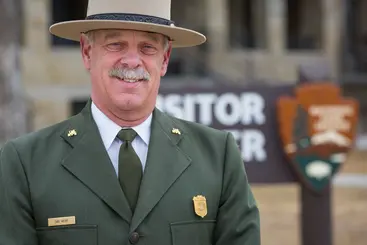Tourism is a booming industry in South Dakota, with iconic destinations like Wall Drug, Badlands National Park, and Mount Rushmore National Memorial drawing millions of visitors each year. As peak season approaches, these attractions rely heavily on seasonal workers, many of whom travel from various parts of the globe to support this segment of South Dakota’s economy.
Wall Drug, located in the small town of Wall, is a cornerstone of South Dakota tourism, famous for its free ice water, 5 cent coffee, fresh donuts, and ubiquitous roadside signs. The attraction boasts more than 2 million visitors annually. To handle this influx, Wall Drug employs approximately 70 year-round staff and hires an additional 120 seasonal workers. This substantial workforce is crucial for maintaining the renowned hospitality and operational excellence Wall Drug is known for.
According to Sarah Hustead, the fourth-generation leader and vice president of Wall Drug, seasonal staffing plays a pivotal role in the business model. “We really count on those workers,” she said, noting that a large portion of these seasonal employees come through the H-2B work visa process. The H-2B visa is crucial for attracting foreign nationals to fill temporary, non-agricultural positions.
 Dan Wenk, former superintendent of Mount Rushmore National Memorial, discusses the importance of seasonal workers.
Dan Wenk, former superintendent of Mount Rushmore National Memorial, discusses the importance of seasonal workers.
The use of the J-1 visa program, intended for students, is another strategy Wall Drug employs to fill its seasonal ranks. “That program is much easier and has been going really well for us,” Hustead explained. Over the years, Wall Drug has become a melting pot of cultures, with workers from Thailand, Kazakhstan, Mongolia, and Jamaica finding temporary homes in this welcoming community.
Just a short drive from Wall lies Badlands National Park, a place of stunning vistas and rich biodiversity. Mike Pflaum, a veteran of the National Parks Service and current president-elect of the Association for National Park Rangers, recalls his first encounter with the park at the age of six: “That memory of going to the first overlook and going, ‘Wow!’ has stuck with me for my entire life.” Badlands, like Wall Drug, relies heavily on seasonal staff to manage its peak periods, with duties ranging from fee collection to conducting visitor programs.
Similarly, Mount Rushmore National Memorial faces its own set of staffing challenges. Dan Wenk, who spent a significant portion of his career as the monument’s superintendent, highlights the importance of seasoned seasonal employees who “would know the park, the stories, and the educational side of what they were going to do.”
The perennial challenge of providing adequate housing for these seasonal workers is a shared concern among South Dakota’s attractions, both federally managed and private. At Wall Drug, efforts have been made to mitigate this issue. The attraction has invested in a variety of housing options, including trailer courts and houses around the town of Wall, to accommodate all of its seasonal employees.
Despite these challenges, the collaboration between attractions like Wall Drug and Badlands plays a vital role in promoting tourism in South Dakota. Hustead has witnessed a communal spirit among local businesses, who often cross-promote destinations to ensure visitors experience all that the area has to offer. “If I have a customer coming through and they’re not stopping at the Badlands, I’m like, ‘You can’t come here and not go through the Badlands!’ And I hear that from other business owners that they’re sending them my way,” Hustead shared.
This mutual support system benefits not only individual attractions but the entire state, reinforcing South Dakota’s reputation as a hospitality hub. With scenic landscapes and vibrant cultural experiences, the state continues to draw in new residents and visitors alike. As Dan Wenk notes, “I think we do have in South Dakota more and more amenity migrants – people who are coming from other places to come to South Dakota because of the amenities that we have, and the public lands are part of that.”
The season finale of “South Dakota Focus” will air on Thursday, May 29, addressing these themes and offering insights into the intersection of tourism and community in South Dakota. Viewers can catch the episode on SDPB-TV1, YouTube, or SD.net. Questions or comments can be sent to info@sdnewswatch.org.